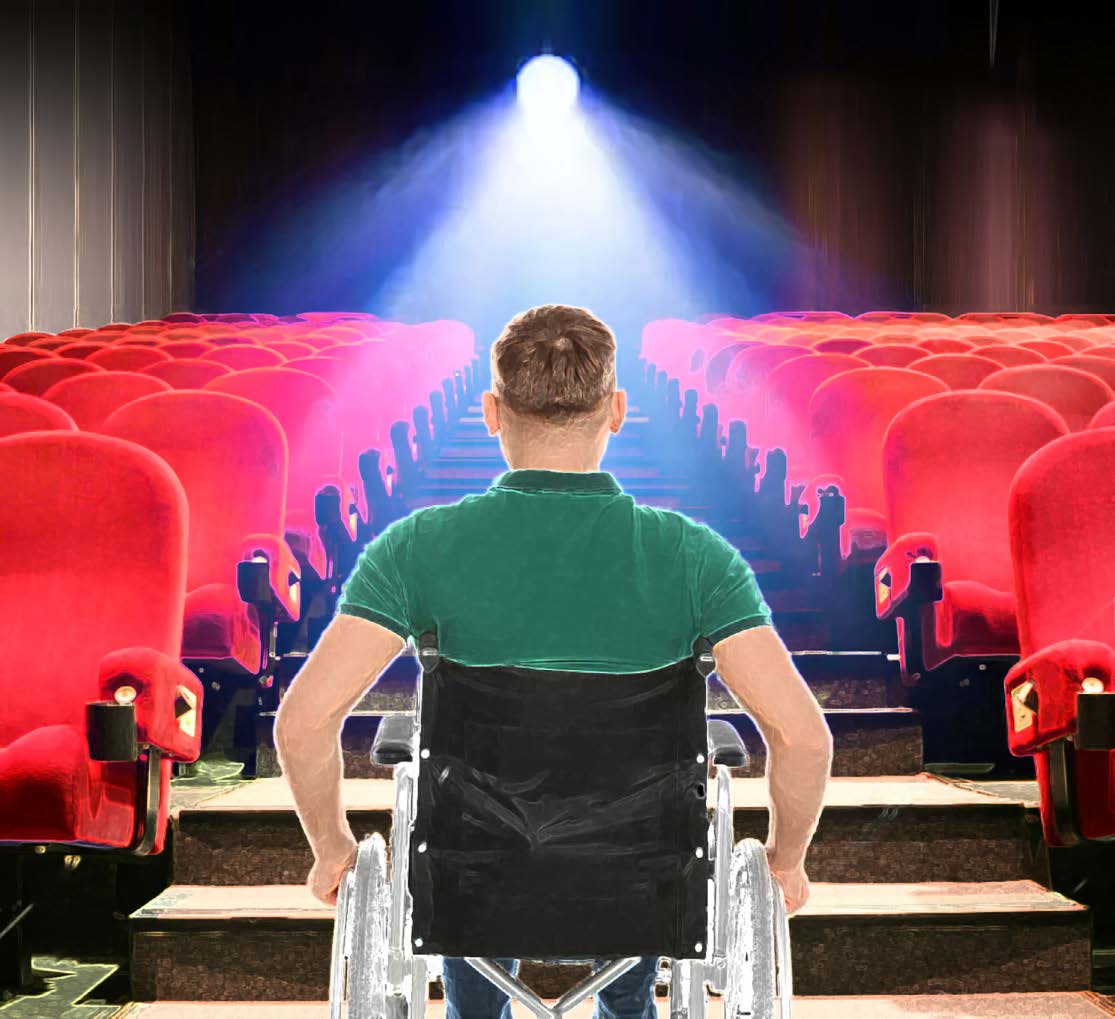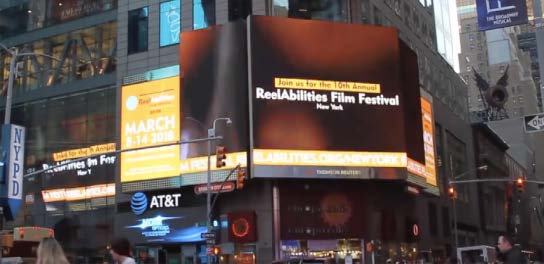
The path to accessibility starts with representation. People with disabilities are highly underrepresented both in front of and behind the camera.
BY ISAAC ZABLOCKI
When going to a summer blockbuster, one might catch the letters CC and AD listed next to the titles. This is not a new parental guide standard, nor a new form of digital experience. It is a listing of the accessibility aids provided for that film, making the films more accessible to all. This is the result of a new ruling which took effect last summer, which enforces all major cinemas to offer Audio Description and Closed Captions for all of their screenings. Despite this step in the right direction, the film industry still struggles with inclusion and accessibility for people with disabilities, and has a long way to go until it becomes truly accessible to all.
The path to accessibility starts with representation. People with disabilities are highly underrepresented both in front of and behind the camera. This fact is especially recognizable in the few films that do include a person with a disability, yet the part is clearly not written or directed by someone with direct access to the world of disability. Typically, those parts are also not casted authentically and ultimately bring to the public visions that have nothing to do with reality – causing a further gap between the perceptions of people with disabilities and the non-disabled community.
In addition to this, many films are first premiered at film festivals and are not shown with the required accessible aids. As the director of The ReelAbilities Film Festival, the largest disability film festival in the country, I go to many festivals and see films relating and not relating to the topic of disabilities. Despite the attempts of some festivals to be more accessible, most fall short of standard.
ReelAbilities Film Festival prides itself on being the most accessible festival in New York, travelling additionally around North America to share accessible films in more locations. Every year, ReelAbilities incorporates new ways to raise the bar on accessibility of film presentations. The ReelAbilities Film Festival is trying to change both the perceptions of people with disabilities – through films that shine new light on this community, and as a festival, has entered the movement for further inclusion. Over the years, the festival has learned ways to provide more accessible events but, more important, it has attempted to change generally accepted notions surrounding accessibility and inclusion for people with disabilities.
When we began the ReelAbilities Film Festival more than 12 years ago, in our attempts to be accessible, we presented all of our films with Open Captions (OC). This meant that the entire audience saw the captions on the screen. We felt that if viewers are open to viewing a movie with subtitles, why not have captions presented for all audiences? It was not until year two of ReelAbilities that we realized the needs of the vision loss or blind community and added Audio Description to select films and upon request.
However, we believe one should not have to request access, but rather that it should be a given. This is why we worked to make all of our films fully accessible. This is not an easy task. Many film festivals present films in fully accessible theaters, but if the films themselves do not have the accessibility aids provided, these fea tures cannot be utilized. Most films do not create these accessibility aids when they are submitted to a festival – they only create these aids when required for a formal mainstream release. Therefore, for ReelAbilities, we need to create the captions and audio description for almost all the films, which is a very involved process of thoughtful script writing of all the visuals plugged in between dialogue in the least intrusive way, or in the case of a foreign film, adding the dialogue too for all spoken parts, and recording this and formatting correctly into the film – all with a very quick turnover time. This should be part of the artistic process of filmmaking, rather than an afterthought of the distribution process.
Most festivals and arthouse screenings do not present films with accessibility aids. Even if they do, many often do not create materials that are accessible or have their conversations presented in the most accessible way. With aging boomers in this country who make up a large number of arthouse filmgoers, there is more need for access than ever before. Visual and hearing impairments are leading needs of this community. Theaters need to start thinking about how they can better accommodate beyond the standard.
The Americans with Disabilities Act (ADA) was passed nearly 30 years ago providing equal access to all, and we've come a long way since then. But beyond the given right, there needs to be a cultural shift to facilitate lasting change. If we do not see more people with disabilities on our screens, in our environment, and represented in our cultural space, the efforts for accessibility will fall short. People with disabilities were not a part of the film experience for so long that we need to start building this culture from scratch. It starts with films that have responsible portrayals of people with disabilities. We need to see more actors with disabilities, more extras with disabilities, more correct depictions of disability life experiences. If you look at Hollywood films, you would think disabilities rarely exist, as opposed to the twenty percent of society that it makes up. People with disabilities should be able to see themselves on the screen and be a part of the story (and not just a dramatic twist). Often, people with disabilities are depicted as a source of pity, for an easy emotional effect, or dramatized as superhumans or villain characters. Very rarely do we get to see the complex and normal human existence of people with disabilities. The disabled community should be depicted as part of the fabric of our society, with normal human experiences.
We should simultaneously be more aware of how to serve the disabled community. This is often forgotten as we attempt to create a more diverse and inclusive society. How can we be more welcoming at events? From soup to nuts, how can we be more accommodating? Do we hire people with disabilities on our staff? Are there any obstacles for people with all different kinds of disabilities in attending events? We need to take a proactive approach.
Simple elements are often overlooked. Take for example post-screening conversations. Q&A screenings should all happen with a microphone that runs through the same sound system as the film as to reach T-Coil hearing aids where provided. And of course, questions from the audience should be asked through the microphones as well. I rarely see this being done. Of course, if the films are finally captioned, should we not also provide live captions of the conversations? We need to ensure that everyone can feel a part of the full experience.
Technology is changing cinema and making accessibility easier. The digital world allows multiple layers of data to be displayed on the screen with relative ease. Still, the new screening formats should allow captions to be put up on the screen and not only sent to the little personal screens or the mirrored option that most theaters use. Who thought that having captions on a separate little screen was a good way to view a film? Some countries use special glasses for captions. But why not screen films with open captions? I personally love watching the captions on my Netflix screen. America's fear of titles in movies needs to change. We should not be afraid of reading. Ask any European, it becomes unnoticed and second nature to the point that you will miss it when they are gone.
Most important, we need to create a welcoming environment. Once everyone feels welcome at every screening, we will see more people actually using these aids and joining the culture of filmgoers. It will not happen overnight, but once we see the change in the movies, the cultural change can happen off the screen as well.•
RAISING EXPECTATIONS: The ReelAbilities Film Festival is trying to change both the perceptions of people with disabilities — through films that shine new light on this community, and as a festival, has entered the movement for further inclusion.
ABOUT REELABILITIES FILM FESTIVAL: NEW YORK: Founded in 2007 by the Marlene Meyerson JCC Manhattan, ReelAbilities Film Festival: New York is the largest festival in the country dedicated to promoting awareness and appreciation of the lives, stories and artistic expressions of people with different abilities. The weeklong festival is renowned for its wide-ranging international film selection, riveting conversations, and performances, presented annually in dozens of venues across the New York metropolitan area. In 2010, ReelAbilities Film Festival: New York expanded into a national program, presenting its one of a kind programming in cities throughout the United States. More information is available at reelabilities.org

ABOUT THE AUTHOR:
Born in New York, Isaac Zablocki grew up in Israel and served in the IDF's leading film unit as an educational film producer. He attended film school at Columbia University and went on to work at Miramax films. At the Marlene Meyerson JCC Manhattan, he runs weekly screenings, and programs multiple film festivals annually including the acclaimed Other Israel Film Festival and Reelabilites: NY Disabilities Film Festival. Isaac has developed the largest online database of Israeli films as well as Israel Film Center Stream, the leading site for streaming Israeli films. Isaac lectures around the world in major institutions and writes for a variety of publications including the Huffington Post.